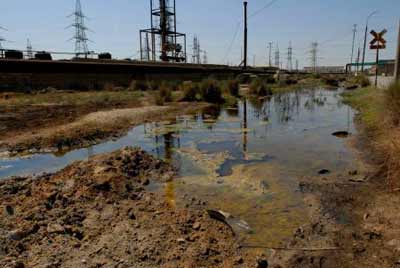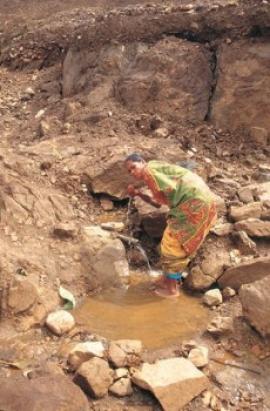Sukinda, India
- Potentially Affected People: 2,600,000
- Type of Pollutants: Hexavalent chromium and other metals
- Source of Pollution: Chromite mines and processing
The Problem
Sukinda Valley, in the State of Orissa, contains 97% of India's chromite ore deposits and one of the largest open cast chromite ore mines in the world. Twelve mines continue to operate without any environmental management plans and over 30 million tons of waste rock are spread over the surrounding areas and the Brahmani riverbanks. Untreated water is discharged by the mines into the river. This area is also flood-prone, resulting in further contamination of the waterways. Approximately 70% of the surface water and 60% of the drinking water contains hexavalent chromium at more than double national and international standards and levels of over 20 times the standard have been recorded. The Brahmani River is the only water source for the residents and treatment facilities are extremely limited. The State Pollution Control Board has conceded that the water quality at various locations suffers from very high levels of contamination. The air and soils are also heavily impacted.
Health Impacts
Chromite mine workers are constantly exposed to contaminated dust and water. Gastrointestinal bleeding, tuberculosis and asthma are common ailments. Infertility, birth defects, and stillbirths and have also resulted. The Orissa Voluntary Health Association (OVHA), funded by the Norwegian government, reports acute health problems in the area. OVHA reported that 84.75% of deaths in the mining areas and 86.42% of deaths in the nearby industrial villages occurred due to chromite-mine related diseases. The survey report determined that villages less than one kilometre from the sites were the worst affected, with 24.47% of the inhabitants found to be suffering from pollution-induced diseases.
Status of Clean-Up Activity
Sukinda is a classic example of pollution where the wastes are spread over a large area and residents are affected by the chromium through multiple pathways. The pollution problem from the chromite mines is well known and the mining industry has taken some steps to reduce the levels of contamination by installing treatment plants. However, according to state audits from Orissa, these fail to meet agency regulations. The Orissa government has said, "It is unique, it is gigantic and it is beyond the means and purview of the [Orissa Pollution Control] Board to solve the problem."
Various organizations have carried out studies proving the debilitating health impacts of the toxic pollution. However, remediation actions remain piecemeal with no decisive plans to provide for effective health monitoring and abatement programs.
* UPDATE April 25, 2008 * Additional details from the government have disputed earlier studies.
The report is attached, for comparison and review, and indicates that health impacts are lower than was earlier indicated.
Resources
http://www.geocities.com/envis_ism/news36_28.html
http://mines.nic.in/anrep04-05/chapter7.pdf
http://www.mmpindia.org/madhavan/pages/14.htm
http://www.atsdr.cdc.gov/tfacts7.html
http://rajyasabha.nic.in/book2/reports/petition/127threport.htm
Additional Photos
 |
Women workers are exposed to contaminated dust and water. Common ailments are gastrointestinl bleeding, tuberculosis and asthma. Photo Credit: P. Madhavan/MMP-India/Blacksmith Institute |
 |
Untreated sewage and mercury-contaminated sludge continue to be dumped haphazardly from chlor-alkali industries. Photo Credit: Petros Morgos/Blacksmith Institute |




